Progress report for SNE22-006-MD
Project Information
Historically, the Delmarva (Delaware-Maryland-Virginia) Peninsula was a major hub for strawberry and raspberry production. However, current commercial production is negligible on the Eastern Shore (Somerset-Wicomico-Worcester) of MD. Similar situations exist in Delaware and Virginia. The cultivation of June bearing (JB) strawberries using the traditional matted row system is the only source of farm income during the spring season and thereafter most of the produce is imported from distant states. Similarly, growers in these areas are heavily depended on floricane fruiting type raspberries (FFTR) that too on small acreage. The cultivation of FFTR requires two year for fruit production and consume time and resources for pruning and disease management. In fact, cultivation of both the berries is negligible on the Eastern Shore with no information available on raspberry acreage in 2017 USDA Census of Agriculture. Most of the local growers have no idea about the existence of day neutral strawberries (DNS) and primocane-fruiting type raspberry (PFTR) varieties, which can extends the harvest season. This proposed extension outreach work will demonstrate sustainable approaches to extend the growing season using multiple JB and DNS under low and high tunnels and open bed regimes. Similarly, our sustainable approach to complement the existing FFTR cultivation system by PFTR under high tunnels regimes will accelerate the local berry production with more profit at farm. Our extensive extension plan (multiple hands-on training) will initiate the rejuvenation of strawberry and raspberry cultivation on the Eastern Shore of MD to benefit socially disadvantaged farmers, women farmers, small farmers, veteran farmers, and BIPOC (black indigenous and people of color) growers. The advisory board of this extension program is highly diverse, comprises extension agents, local growers, veteran farmers, BIPOC organizations, consumers, and faculty members to incorporate holistic education, and subsequently reaches to farmers from all the strata of the farming community.
Centering and Belonging Mini-Project
Northeast SARE offered additional funding to State Coordinators to reach historically underserved farm communities.
Organizing a two-day hands-on workshop (7/1/2025) focused on various agricultural aspects at the University of Maryland Eastern Shore (UMES), Maryland, is critical for assisting new and veteran BIPOC (Black, Indigenous, and People of Color) farmers in reducing stress and launching successful agricultural ventures. First and foremost, agriculture may be a therapeutic and gratifying hobby for veterans moving to civilian life. Hands-on farming activities provide a feeling of purpose, structure, and a strong connection to the land, all of which help to reduce stress and improve mental health. Second, practical training designed exclusively for the needs of new and veteran BIPOC farmers address their unique issues. Participants in hands-on learning experiences can gain critical skills in crop cultivation, animal management, and sustainable farming techniques, all of which are required for creating and maintaining successful agricultural operations. Additionally, conducting the event at UMES provides access to professional staff, resources, and facilities designed specifically for agricultural teaching and research. UMES's Maryland campus offers a great atmosphere for learning and networking, with a rich agricultural landscape and a friendly community of farmers and industry professionals. Overall, the planned workshop at UMES provides a comprehensive strategy to assisting new and veteran BIPOC farmers by addressing their mental health issues, delivering practical agricultural training, and cultivating a supportive network for long-term success. This project reflects our commitment to assisting individuals who have served our country and empowering them to succeed in the agricultural sector.
10 Agriculture service providers who enrich their knowledge of season extension in strawberry and raspberry crops will teach 25 farmers about the use of June bearers and day-neutral strawberries and primocane raspberries for season extension in association with low and high tunnels. 10 Agricultural Service Providers will provide individual consultation and advice to 20 interested growers. 10 Agriculture service providers will further disseminate the work by the publication of factsheets and online study materials to 45 farmers and host workshops using the University of Maryland Eastern Shore (UMES) Small Fruit Plots for 45 farmers.
Description of Problem or Opportunity
Strawberries are economically important and a consumer favorite in the USA with a total production of 2.6 billion pounds (lb) in 2020 (USDA-NASS, 2021). In spite of increasing domestic demand, local production in several eastern states declined and almost nonexistent in local areas (Rom et al., 2014). Earlier (1919) USDA-NASS Census of Agriculture showed the existence of 5,260 strawberry farms and 7,000 acres with strawberry cultivation in Maryland (MD), which is now restricted to 146 farms and 210 acres (USDA-NASS, 2017). These data show a decline in strawberry acreage by 97% within a century. We are expecting further declines in strawberry production on the Delmarva Peninsula due to inclement weather throughout the growing season of JB and day neutral cultivars (DNC).
Currently, there is little production out of the main April-June period; therefore, season extension is essential for strawberry market and profit at farm. The strawberry industry in Mid-Atlantic is chiefly dominated by JB, short day cultivars, which restrict the peak production to spring or early summer seasons only, thereafter the primary supply is maintained by import from California (Mar.-Nov.) and Florida (Dec.-Feb.).
Similarly, raspberries (Rubus idaeus L.) are an economically important crop in the USA. Raspberries are also grown in the NE USA and Mid-Atlantics, but this production is not sufficient to fulfil the local demand. Raspberry production is negligible in the Tri-county area (Wicomico, Somerset, and Worcester) on the Eastern Shore of Maryland (USDA, NASS, 2017). There are only 4-small farms in Wicomico and Worcester County, which occupy a total area of less than 1 acre with raspberry cultivation (USDA, NASS, 2017).
Raspberry is a temperate crop, bears perennial roots, and short lived woody shoots called ‘canes’ (Sonsteby and Heide, 2008). These short-lived canes are of two types; biennial floricanes and annual primocanes. However, in floricane raspberries, the plants survive for two seasons and require labor-intensive pruning and protection from chilling temperatures (Pritts, 2008). Primocane-fruiting raspberries can extend the season from late summer into fall while floricanes harvest is restricted to six weeks during summer (Pritts, 2008). Moreover, annual removal of primocanes can limit the annual cycle of pests and pathogens, thus decrease expenses for fungicides and insecticides.
In 2020, under COVID-19 situation, I established an online coalition of growers and consumers with 181 active members throughout the Delmarva Peninsula to deliver online SARE workshops. An online request was communicated with coalition members to provide inputs on strawberry/raspberry cultivation challenges faced by them and to be the part of the advisory committee to develop the current extension outreach proposal. 15 farmers provided following challenges and knowledge gaps, which are incorporated in this proposal. In addition, our previous work on strawberry crop also showed some of these indigenous challenges. A: Source of strawberry and primocane raspberries, B: How to make raised beds? C: How to grow DNS? D: How to construct inexpensive low tunnels, E: Strawberry varieties suitable for Delmarva Peninsula, F: Technique for high tunnel production of strawberries and raspberries, G: Common pest and pathogen management.
Proposed Solution:
Even though strawberry industry is declining on the Delmarva Peninsula (USDA-NASS, 2017), there is no comprehensive extension outreach work was done on the production potential of multiple JB and DNC in open bed (OB) and high and low tunnel (HT/LT) regimes. A new system of strawberry cultivation, plasticulture system has showed improvement in yield and fruit quality compared to the matted row system (Fiola et al., 1995). Introduction of the HT system has been shown to advance the growing season of JB with early and high yield. HT protects the crop from low temperatures during the fall, early spring frosts, and as a consequence generates more revenue at the farm level (Rowley, 2010). We will demonstrate season advancement using the JB and HT/LT combination. To further extend the strawberry season beyond summer, we will demonstrate the cultivation of suitable DNC, which are insensitive to day length and have multiple harvests throughout the season (Lewers et al., 2017). We will demonstrate that the cultivation of JB and DNS in HT and LT regimes will extend the strawberry season by 10 months (March to Dec.) for local markets.
Weather conditions are ideal for raspberry cultivation in our area, dominated by cool days and sufficient sun light during summer and autumn. These conditions can extend the harvest season from early June to late December. The primocane-fruiting raspberries bear fruit in late summer and fall and later in winter, canes can be removed at ground level to allow new crop in spring. Primocane-fruiting raspberries can extend the season from late summer into fall while floricanes harvest is restricted to six weeks during summer (Pritts, 2008). Moreover, annual removal of primocanes can limit the annual cycle of pests and pathogens, thus decrease expenses for fungicides and insecticides. Cultivation of PFTR is a potentially profitable enterprise for small farmers on the Delmarva Peninsula. Moreover, use of HT cultivation of primocane will also improve fruit quality and season extension during fall months.
Service Provider Interest:
Agriculture service providers in this proposal comprises of county extension agent (2), urban agriculture agent (1), administrators and members of BIPOC farmer organization (2), veteran agriculture instructors (1), multi-disciplinary faculty members (4), socially disadvantaged growers (45), veteran growers (16), and 181 members of online coalition of growers and consumers on the Delmarva Peninsula. We are expecting to develop a ‘Small Fruit Team’ (8 or 10 trained extension personnel) and trained farmers (45) during the three years of this project. So far, only 2 extension agents (Urban Agriculture/Veteran agriculture instructor) committed participation in this program. They will attend the workshops and help in extension outreach. Other Ag. extension agent on the Delmarva Peninsula will also be communicated to participate in this program. However, 10 farmers showed willingness to help other farmers after getting hand-on training through this program.
Educational Approach
Engagement:
Project PI, Ag. service providers, and recruited local growers on the Delmarva Peninsula will communicate with other interested farmers to participate in this project over a period of 3-year. Each year educational materiel on previous workshops will be provided to new growers to keep them up to date on subject matter. Ag. service providers and farmers will use UMES small fruit plots for extension outreach events. In addition, UMES extension website will be provided to Ag. Service providers to communicate online or though the publication of factsheets. Educational PowerPoint will be shared with the Ag. Service providers to use during their independent workshops and one to one consultations.
Surveys of service providers will be conducted each year in October and information will be collected on their extension outreach activities related to this project. Collected information will be used to verify teaching actions and further suggestions/development/modification will be incorporated in the extension plan in the successive years.
Learning:
Each year four-extension events will be organized during October (June Bearers strawberry sowing), April (Day Neutral Strawberry and Floricane and Primocane Raspberry sowing), June (June Bearers strawberry and Floricane raspberry harvest), and September (Day neutral and primocane raspberry harvest) of each year at UMES. In addition to above mentioned four workshops, two more workshops will also be conducted for US service veterans in Baltimore in association with NGO, TALMAR. Ag. service providers in association with project PI will participate in teaching and demonstration classes during these workshops.
Educational approaches at each event will include a classroom presentation followed by the small fruit plot visit. All the practical trainings will be conducted at UMES experimental small fruit plots (low tunnels, high tunnels, and open bed) to observe the various phenology of fruit growth and development. Online classes will also be conducted using the Zoom platform. YouTube video will be created for field demonstrations and classroom teaching and link will be displayed on the UMES extension website and social media platforms (UMES- Horticulture Physiology Facebook Page; 200 growers are the current members on this page) to reach multiple stakeholders. In addition, visits to small fruit team members farms will be facilitated to promote farmer-to farmer leaning. Printed and online material will be provided to attendees after each workshop and through email communication.
We expect our program will enrich the following knowledge base of extension service providers and participating farmers to establish small-scale strawberry and raspberry cultivation plots to diversify fruit production on the small farms.
I: Understanding of DNS and PFTR phenology.
II: Selection of JB, DNS, FFTR and PFTR varieties suitable for the Delmarva Peninsula.
III: Raised bed preparation and use of raised bed machine.
IV: Construction of low tunnels and microenvironment within the high tunnels.
IV: Trellis design for raspberry cultivation within high tunnels and open bed regimes.
V: Fertigation, irrigation, and pest management.
VI: Harvesting stages and marketing approaches.
VII: Popular recipes and value added products from strawberry and raspberry fruits.
VIII: Developing enterprise budget and record keeping.
IX: Information will be provided on USDA/NRCS grants for HT purchase. Local sources of construction material for HT/LT will also provided to growers.
An overview of each year’s outcome will be provided to the new Ag. service providers. In addition, team members can also facilitate farmer’s visits to UMES small fruit plots (low and high tunnel) for education and learning purposes. Team members can also provide online study material to stakeholders or interested parties.
Evaluation:
Following information will be collected from Ag. Service providers and stakeholders.
I: How many farmers/growers attended small fruit workshops, field demonstration, on farm trainings you conducted during the past year?
II: How many farmers showed interest to adapt low tunnel, high tunnel, and day neutral strawberry cultivation technology for the season extension?
III: How many farmers showed interest to adapt high tunnel and primocane raspberry cultivation technology for the season extension?
IV: How many farmers order bare root strawberry plants?
V: How many farmers install high and low tunnels?
VI: How many farmers purchased primocane raspberry plants?
VII: What questions were raised by the farmers during teaching and advising?
IV: What suggestions and recommendations were provided by the farmers?
V: What kind of limitations and obstacles were faced by the farmers?
VI: What they did to teach and advise farmers?
VII: How many email, telephone calls, and face-to face advice was given to interested growers?
VIII: Post workshop evaluation will conducted to test the gain in knowledge, objective achievements, and suggestions to incorporate in the future workshops.
Milestones
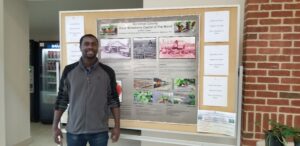
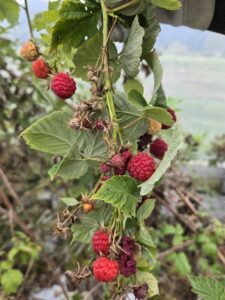
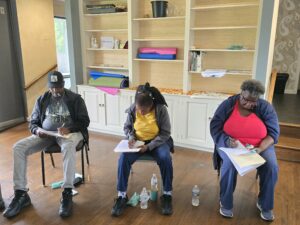
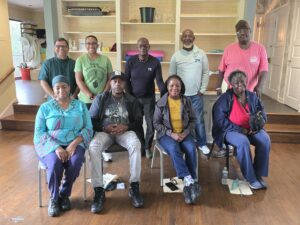
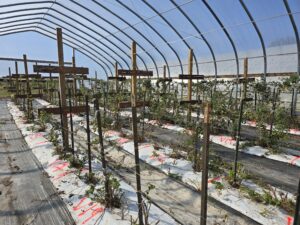
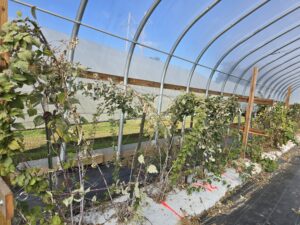
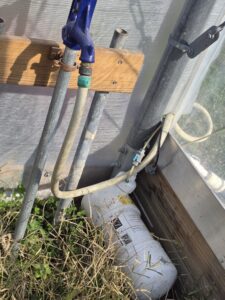
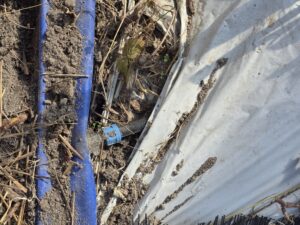
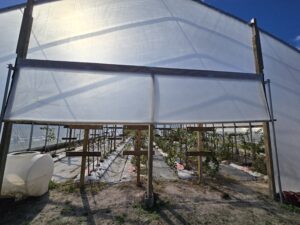
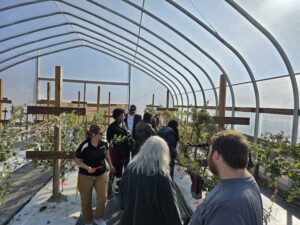
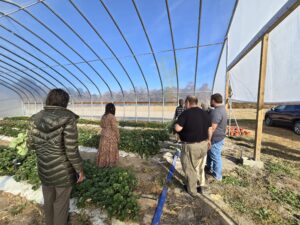
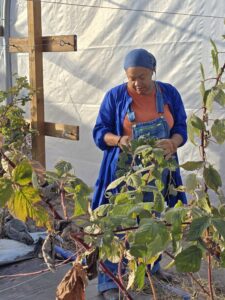
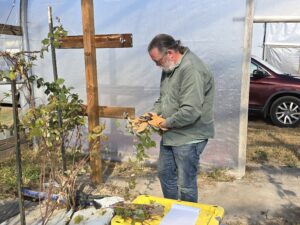
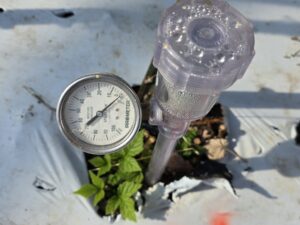
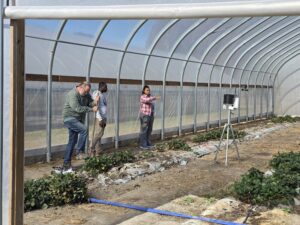
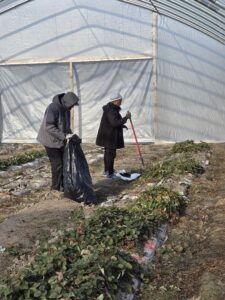
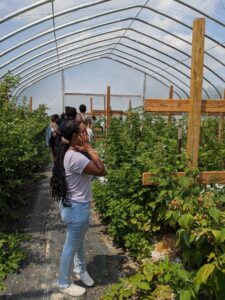
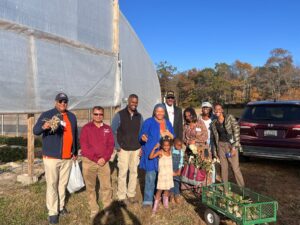
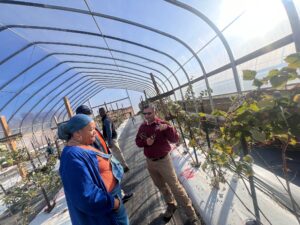
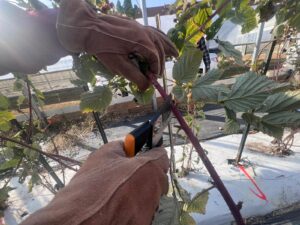
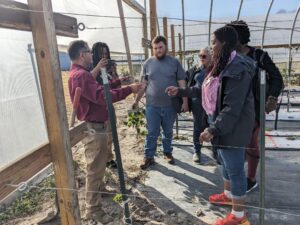
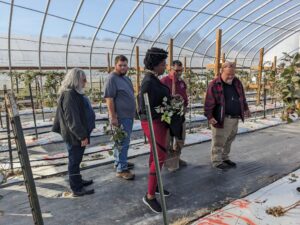
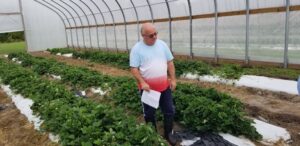
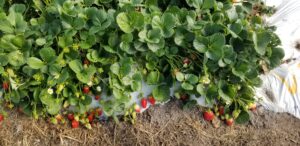
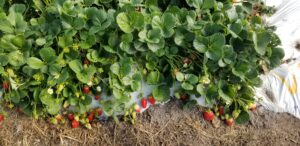
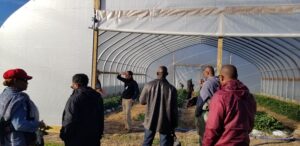
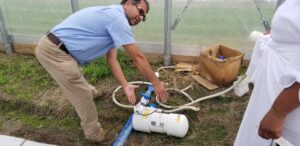
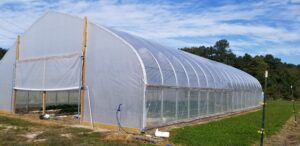
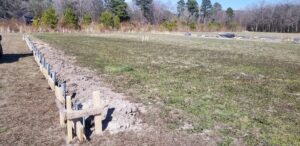
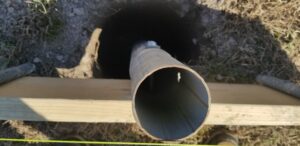
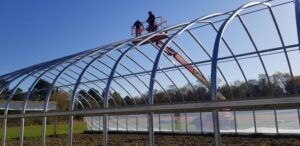
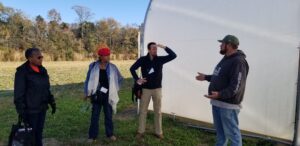
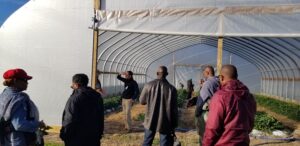
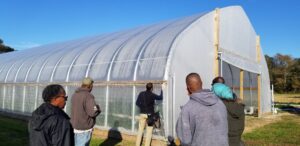
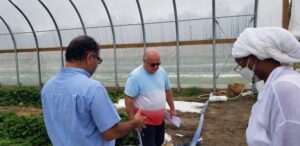
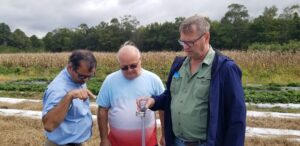
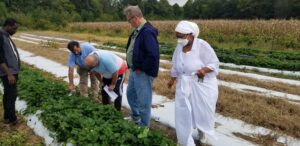
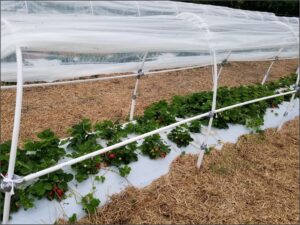
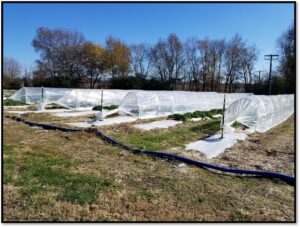
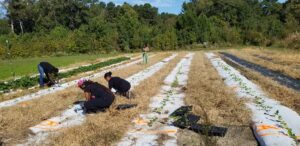
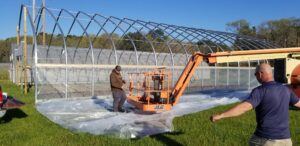
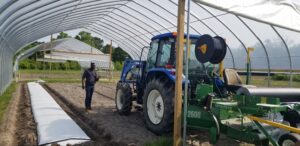
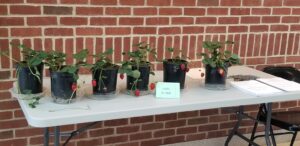
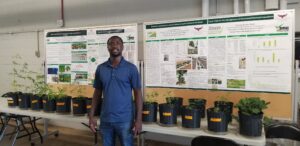
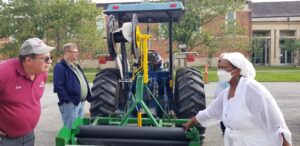
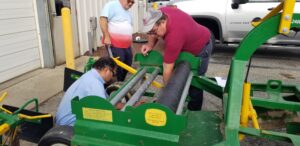
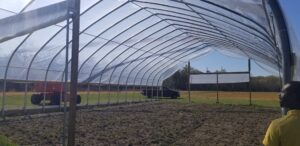
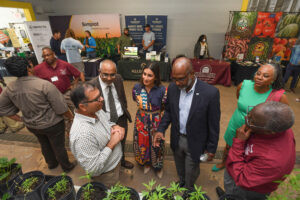
"This program will educate 8 or 10 agriculture service providers and 45 farmers over a period of three years.”
Milestone #1: (October-2022)
2 Agriculture service providers and 5 farmers will be communicated and invited to UMES small fruit plots to discuss the implementation of the proposed proposal. Participants will learn how to use raised bed machines and the phenology of June bearer (JB) strawberries. Information on suitable JB varieties will also be provided to the Ag. service providers and stakeholders. Participants will also be informed and trained for SARE Farmer Grant. Ag. Service providers and recruited farmers will provide this information to other interested farmers.
Milestone 1:
Status: Complete
Date of Complete: 10/7/2023
Accomplishment:
Number of Service Provider: 12
Number of Farmer: 49
Summary:
During the 19th Small Farm Conference (11/4/2022-11/5/2022), 5 Ag. Service Providers and 23 Farmers were recruited for the three-year NE SARE PDP Training Project on Strawberry and Raspberry Season Extension at UMES. Two additional high tunnels were created for training and demonstration purposes to make this notion a reality. To accomplish Milestone-1, four workshops were held: two workshops were held at Therapeutic Alternatives of Maryland (TELMAR), Baltimore, MD, from 5/3/2023 to 5/4/2023. The other two workshops were held at UMES on October 7, 2023. In addition. The outcomes of the seminars were discussed with Ag. Service Providers during the American Society of Horticultural Science (ASHS) Annual Meeting in Orlando, Florida (8/1/2023). Strawberry cultivation, a vital component of horticulture, requires a comprehensive understanding of modern techniques to optimize yields. This workshop provided information to Ag. Service Providers and farmers on how use of raised bed machines, the characteristics of June-bearer strawberry varieties, and the selection of appropriate mulch for raised beds. Workshop focused on the following aspects. Machine Operation: Provided hands-on training on how to operate raised bed machines, emphasizing key features and adjustments for different soil types. Maintenance Techniques: Educated farmers on routine maintenance tasks to ensure the longevity and efficiency of the raised bed machines. This includes blade sharpening, belt adjustments, and lubrication. Optimal Bed Dimensions: Discussed the ideal dimensions for raised beds, considering factors like row spacing, bed height, and overall layout. Explained how these dimensions contribute to effective water drainage and soil warming. Soil Preparation: Guided farmers on proper soil preparation before using raised bed machines, including soil testing, amendment incorporation, and leveling. Workshop and education material also provided information on Mulch Selection: Discussed various mulching materials such as straw, plastic, or landscape fabric. Evaluated the pros and cons of each, considering factors like cost, insulation properties, and environmental impact. Application Methods: Provided guidance on proper mulch application techniques, emphasizing uniform coverage and thickness to maximize benefits. Mulch Maintenance: Educated farmers on routine mulch maintenance, including weed control, replenishment, and removal at the end of the growing season. Impact on Soil Temperature: Explained how different mulching materials can influence soil temperature, affecting strawberry growth and development. This information will aid farmers in choosing the most suitable mulch for their specific climate and soil conditions. Information was also provided on Strawberry Varieties for season extension using early, mid, and late June-Bearer: Understanding the differences between June-bearer strawberry varieties is crucial for farmers to make informed decisions based on their specific needs and growing conditions. Farmers learned June-bearer varieties produce a concentrated harvest over a shorter period, typically in late spring to early summer. Limited harvest window, requiring precise marketing and distribution planning. The impact of providing training on the use of raised bed machines, understanding June-bearer strawberry varieties, and selecting appropriate mulch for raised beds is evident in the verified changes observed in participants' knowledge, attitudes, skills, and actions. 1. Increased Knowledge: Participants indicated a considerable gain in their understanding of the complexities involved in operating raised bed machines. This included a thorough understanding of appropriate bed dimensions and soil preparation processes. Farmers enhanced their awareness of the distinguishing characteristics of June-bearer strawberry types, allowing them to make informed judgments based on their individual agricultural aims and local conditions. Mulching (Black and White type) workshops aided in the advancement of knowledge about various materials, application methods, and the impact on soil temperature regulation. 2. Attitude Shift: Participants expressed greater confidence in adopting raised bed machines, recognizing them as valuable tools for optimizing strawberry yields. The nuanced understanding of strawberry varieties fostered a more adaptable mindset, allowing farmers to embrace diverse cultivation strategies based on market demands and seasonal considerations. Attitudes towards mulching (white for day neutral and Black for June Bearers) also shifted, with participants acknowledging its importance in weed suppression, moisture retention, and overall plant health. 3. Skill Development: Hands-on training sessions provided participants with practical knowledge on how to operate and maintain raised bed machines. Farmers improved their ability to build beds, modify machine settings, and troubleshoot typical problems. Participants learned the significance of white and black type of mulches and their use for specific crops. They also learned how temperate controls flowering in strawberries and concept of day length. 4. Awareness and Action: The training workshops raised participants' knowledge of the interconnectivity of their growing method choices and the larger agricultural ecosystem. 2 farmers will plant combination of day neutral and June Bearer strawberries next season (2024) using bed raised machine to actively shift from conventional to raised bed farming practices. 1 farmer is planning to adapt U-Pick system of marketing for raised bed strawberry cultivation. All the participants improved their mulching skills for strawberry cultivation and will use black type of plastic mulch for June Bearer strawberry cultivation.
Milestone #2: (April-2023)
4 Agriculture service providers and 8 farmers will be invited in the spring of 2023 at UMES small fruit plots to learn the phenology of day neutral strawberries (DNS) and floricane fruiting type (FFT) and primocane fruiting type (PFT) raspberries. Information on suitable varieties of DNS, FFT, and PFT will also be provided to the Ag. service providers. Participants will also learn about the source of local availability of these plants.
Milestone 2:
Status: Complete
Date of Complete: 5/4/2023
Accomplishment:
Number of Service Provider: 6
Number of Farmer: 31
Summary:
To accomplish Milestone-2, three workshops were conducted during May-November, 2023. Two workshops were conducted at Therapeutic Alternatives of Maryland (TELMAR), Baltimore, MD, from 5/3/2023 to 5/4/2023 for the socially disadvantaged beginning veteran farmers and 1 demonstration at UMES during the 20th Small Farm Conference (11/2/2023). 5 Ag. Service Providers and 15 farmers were also recruited for the 2024 NE SARE PDP Training Project on Strawberry and Raspberry Season Extension at UMES. Following information was provided on overview of day-neutral strawberries, emphasizing its distinct feature of continuous fruiting throughout the growing season. Advantages of Season Extension: Discussed the benefits of day-neutral strawberry production, focusing on how it helps farmers to lengthen harvest seasons and meet market demands over a longer period of time. Planting Demonstration: Given a live demonstration of planting day-neutral strawberries, demonstrated optimum procedures for bed preparation, planting depth, and spacing. Hands-on activities relevant to managing day-neutral strawberry plants, such as pruning procedures, pest management, and irrigation strategies, were demonstrated. Variety selection was described in detail for flavor, yield, and disease resistance. Information was provided on bareroot and plug plants and described about their benefits, planting methods, and suitability to certain growth environments. Discussed day-neutral strawberry soil requirements, sunshine exposure, and water management options. Provided fertilization suggestions for day-neutral strawberries at various growth stages. Participants were educated on the most common foliar diseases affecting day-neutral strawberries, as well as how to detect and control them early. Explained the relevance of eliminating early blossoms in order to divert energy toward plant establishment and fruit growth. Highlighted the yield potential of day-neutral strawberries as well as their great taste, stressing their consumer appeal. Provided insights into creating a UPick system, drawing clients to the farm for a one-of-a-kind and hands-on harvesting experience. Discussed effective customer engagement tactics such as farm tours, social media advertising, and community events. These workshops seek to equip farmers with the knowledge and skills required for successful day-neutral strawberry farming, season extension, and effective marketing by combining instructive sessions, hands-on exercises, and interactive demonstrations. Day-neutral strawberry cultivation, mulching for raised beds, irrigation and fertilizer management, liquid fertilizer application, the role of fertilizer injectors, marketing options, and agritourism have all had a significant impact, as evidenced by verified changes in participants' knowledge, attitudes, skills, awareness, and subsequent actions. 1. Increased Knowledge: Participants indicated a significant increase in knowledge about the benefits of day-neutral strawberries for season extension as season can be extended up to 9 months. Understanding the best mulching techniques (White type to regulate temperature during summer months) for raised beds, irrigation tactics (use of irrometer for irrigation scheduling) for the efficient use of water. The role of liquid fertilizers and the efficient use of fertilizer injectors for accurate nutrient administration. 2 farmers will use irrometer and fertilizer injector next season for the efficient management of water and fertilizer for sustainable strawberry cultivation. 2. Attitude Shift: A positive shift in attitudes towards adopting sustainable and season-extending practices was observed. Participants embraced the potential of day-neutral strawberries as a means of diversifying their crop calendars, leading to increased income at farm. Attitudes towards mulching (white outside and black inside) evolved, with participants recognizing its role in weed suppression, moisture retention, and soil health improvement. 3. Skill Development: Hands-on sessions improved practical abilities in day-neutral strawberry farming, including as planting, maintenance, and pest control. Participants mastered the application of liquid fertilizers with injector devices, maximizing nutrient delivery. Practical irrigation instruction on how to use irrometer prepared them to handle water efficiently in a variety of growing environments. 15 participants looking for a inexpensive type of fertilizer injector. 4. Awareness and Action: Participants are planning to diversify marketing tactics and agritourism potential such as farm tours and community engagement. This move reflected a greater knowledge of the relationship between sustainable agriculture practices and successful marketing efforts. 4 participants are planning for UPick system and youth education at farm. Adoption of these techniques not only demonstrated a commitment to sustainable agriculture, but also helped to the economic viability and resilience of farming communities. The positive changes seen highlight the importance of focused education in promoting agricultural practices and developing a more sustainable and economically viable farming community. Workshops on raspberries will be conducted next year as these plants are still growing and we are in the process of developing trellis system.
Milestone #3: (July-2023)
6 Agriculture service providers and 10 farmers will be invited in the summer of 2023 at UMES small fruit plots. Participants will learn how to construct inexpensive low tunnels (LT) to enhance the season extension of DNS. Participants will also learn how LT protects DNS from rainfall mediated fungal diseases. New team members who will join the project at later stages will receive previous educational materials to keep pace with the project. Local sources for LT materials will be provided to participants.
Milestone 3:
Status: Complete
Date of Complete: 9/29/2023
Accomplishment:
Number of Service Provider: 3
Number of Farmer: 13
Summary:
To accomplish Milestone-3, one workshop was conducted during September, 2023. Workshop conveyed step-by-step construction of low tunnels using PVC pipes, twine, and tape. Participants were explained the advantages of low tunnels in season extension, disease reduction, and improved fruit quality. Greenhouse films play a crucial role in controlling the growing environment within a low tunnel, influencing factors such as light transmission, heat retention, and durability. Participants were provided information on types of greenhouse films such as infrared films, anti-condensation films, diffused films, acrylic films, ethylene vinyl acetate films, polycarbonate films, polyvinyl chloride films, and polyethylene films for low tunnel construction. Shared success stories of farmers who have implemented low tunnels for disease management and higher yield of day neutral strawberries. Participants were also provided information on the budget of low tunnel construction. The educational programs centered on low tunnel construction utilizing low-cost materials such as PVC pipes, twine, tape, and various types of greenhouse films resulted in significant and validated changes in participants' knowledge, attitudes, skills, awareness, and actions. 1. Increased Knowledge: The participants demonstrated a significant increase in knowledge regarding the building and application of low tunnels. There was a shared knowledge of the basic principles at first, but as the sessions went, participants gained deeper insights into material selection, structural design, and the vital role of different types of greenhouse films. They got a thorough understanding of how UV-blocking and UV-transmitting films can effectively manage diseases and insects’ movement within a low tunnel and how light spectrum control help to extend the growing season and improve fruit quality. Specially success story of Mr. Mike from Virginia, who documented higher day neutral strawberry yield using low tunnels, encouraged participants to use low tunnels for strawberry cultivation. 1 socially disadvantaged women farmer and 1 beginning farmer are planning to use low tunnels for strawberry cultivation and other crops. 2. Attitude Shift: The workshop resulted in a positive shift in attitudes about the use of low tunnels as a viable and cost-effective alternative for improving strawberry cultivation. Participants initially questioned the simplicity of materials like PVC pipes, twine, and tape, but they gradually accepted these elements as accessible tools for producing efficient low tunnel structures. Participants recognized the economic benefits of adopting affordable materials without sacrificing efficacy as they became more aware of the possible benefits of various greenhouse films. 3. Skill Development: Participants developed actual skills that went beyond academic knowledge, such as learning to bend PVC pipes and precisely secure greenhouse films. Low tunnel construction became a concrete skill set, allowing participants to repeat the technique on their own farms. The acquired abilities extended beyond construction to include material selection, efficient assembly processes, and proper film installation, all of which contributed to the participants' confidence in properly implementing low tunnels. Participants documented how simple it is to build low tunnels. 4. Awareness and Action: 2 participants planning to put low tunnels up on their fields, displaying a proactive attitude to sustainable agriculture. The planned modification of light spectrums for season extension and the strategic use of UV-transmitting/blocking films for disease management demonstrated a greater grasp of the subtle elements impacting successful strawberry cultivation.
Milestone #4: (October-2023)
8 Agriculture service providers and 12 farmers will be invited in the fall of 2023 at UMES small fruit plots. Feedback will be collected from the participants to further improve the extension outreach program. Participants will learn about the management/purchase/parts/operation of high tunnels (HT) and associated problems. Participants will also be informed about the NRCS grant for HT. Participants will also be informed and trained for SARE Farmer Grant. Participants will also be informed about the local sources of HT construction material. Members of team (8 or 10) and farmers who patriciate in the earlier workshops responds to annual verification to report on teaching and assistance about strawberry and raspberry cultivation.
Milestone 4:
Status: Complete
Date of Complete: 11/02/2023
Accomplishment:
Number of Service Provider: 5
Number of Farmer: 15
Summary:
High tunnels (HT) have become invaluable assets for farmers, providing controlled settings that boost crop output and protect against inclement weather. Comprehensive information is essential for arming farmers with the knowledge and resources required for successful high tunnel use. Management, buying considerations, maintenance, operation, and the possible NRCS grant for high tunnels are among the topics covered in workshops and programs. Participants were instructed on the day-to-day operation of high tunnels, with an emphasis on the following essential areas: Strawberry variety selection for high tunnel farming was provided, taking into account local climate conditions, soil quality, and market demand. Participants learned how to regulate ventilation and temperature in order to produce an ideal microclimate for strawberries. Effective water management was emphasized, including drip irrigation and the importance of maintaining adequate moisture levels for strawberry. Participants were given advice on how to make educated selections when acquiring high tunnels. Advice on selecting the best materials, size, and design to meet specific farming needs and environmental conditions. Understanding the many ventilation options available and selecting systems that are compatible with the crops being grown. Comparisons of various covering materials, such as single or double layers of polyethylene, and their effects on light transmission, insulation, and durability. Participants were also educated on the value of endwall design in improving air circulation and structural integrity. Detailed information was provided on high tunnel parts and operation by Mr. Brian, Farm Crew Member, UMES; I: Step-by-step instructions for assembling high tunnel frames while maintaining structural integrity and stability. II: Demonstrations of proper covering material installation, including fastening, tightening, and sealing to enhance performance. III: Instruction on how to use roll-up side walls to effectively control temperature and humidity. IV: Endwall management techniques for optimizing airflow and preventing damage during harsh weather events. Participants were trained on frequent high tunnel farming issues and viable solutions. Information was also provided on strategies for preventing and managing diseases and pests in the high tunnel environment, methods for preventing fungal illnesses by resolving condensation difficulties and maintaining ideal humidity level, and training on frequent inspection and maintenance techniques to guarantee high tunnel lifetime and functionality.
The educational programs focused on the building, management, procurement considerations, parts, operation of high tunnels (HT), and addressing associated difficulties resulted in deep and verifiable improvements in participants' knowledge, attitudes, abilities, and behaviors. These courses not only provided participants with practical skills, but they also facilitated a paradigm shift in their approach to high tunnel agriculture. 1. Increased Knowledge: Participants indicated a significant increase in knowledge across multiple aspects of high tunnel farming. Participants gained an in-depth understanding of high tunnel construction, structural concerns, covering materials, and the complexities of optimal operation through workshops and hands-on activities. They gained a thorough awareness of issues such as disease management, pest control, and structural maintenance, allowing them to make informed decisions. 1 team member/participant got NRCS funded high tunnel for day neutral strawberry cultivation in the Wicomico County, MD. Based on recommendation of this program, two high yielding day neutral strawberry varieties (Seascape and Portola) will be cultivated in the next season (2024). 2. Attitude Shift: These workshops caused a beneficial transformation in participants' perceptions. Some participants may have initially seen high tunnel farming as complicated or out of reach. However, when they obtained hands-on experience and a greater grasp of the practical issues, their perception shifted noticeably. Participants began to regard high tunnels as not only practical but also necessary tools for optimizing strawberry yield, extending growing seasons, and managing weather hazards. Using high tunnels, we can demonstrate day neutral strawberry growing in Somerset County, MD until the third week of December. One female farmer will apply for NRCS-funded high tunnels in the next year. 3. Skill Development: Practical workshops were critical in participants' skill development. Participants developed skills in everything from building high tunnels and assembling their pieces to operating ventilation systems and addressing associated challenges. The information shared by the person who constructed these high tunnels at UMES created confidence that went beyond theoretical knowledge. Participants were not only educated, but also given the ability to implement what they learned in real-world high tunnel farming circumstances. Participants can order type of high tunnels they are interested in and similarly type of strawberry variety they want to grow for season extension. In fact, high tunnels can be the integral part of agritourism and can promote crop sale at the farm. Visitors can experience sustainable farming practices through high tunnels, which provide an immersive and educational component to agritourism. Exciting tours of these enclosed constructions provide insights into season extension, crop production, and technological integration. By demonstrating innovative and environmentally sensitive farming methods, high tunnels enhance the overall agritourism experience. 2 participants will allow UPick approach under high tunnels. 4. Awareness and Action: The workshop promoted a proactive approach, urging participants to include high tunnels into their overall farm management practices. In addition to strawberries, participants intend to cultivate other minor fruits and vegetables under high tunnels. One participant intends to use high tunnels to cultivate cut flowers and sweet potatoes. 5. Impact on Farming Practice: The verified changes in knowledge, attitudes, and skills have had a discernible impact on participants' farming practices. The implementation of high tunnels has resulted in extended growing seasons, improved crop yields, and enhanced resilience against adverse weather conditions. Participants reported a decline in disease incidences and improved pest management, indicative of the practical benefits derived from the workshops. 1 participant is embracing a dual approach, this participant plans to cultivate potted strawberries within high tunnels, offering not only luscious fruits but also thriving potted plants. By introducing this diverse product range at farmer markets, the participant aims to cater to both consumers seeking fresh, homegrown strawberries and those interested in cultivating their own berry-producing plants, creating a unique and appealing market proposition. 6. Adoption of Sustainable Practices: The workshops emphasized the need of sustainable and resource-efficient farming techniques in addition to technical considerations. Participants learned about soil health, water management, and organic pest control strategies. This broader perspective has contributed to a more environmentally responsible and sustainable approach to high tunnel agriculture. 2 socially disadvantaged participants shared their views to grow organic strawberries in high tunnels is a sustainable and environmentally friendly method. High tunnels produce a controlled environment that lowers the need for hazardous chemicals to control weeds and diseases. The enclosed building acts as a natural barrier against pests and reduces exposure to external toxins, making organic methods possible. This strategy is consistent with organic farming principles, encouraging soil health, biodiversity, and consumer well-being while providing a realistic answer for farmers committed to sustainable agriculture.
Milestone #5: (April-2024)
8 Agriculture service providers and 15 farmers will be invited in the spring of 2024 at UMES small fruit plots. Education will be provided on nutrition management in JB and DNS. Participants will learn about the use of fertilizer injector, fertilization calculations, and the benefits of liquid and granular fertilizers. Ag. service providers will produce factsheets and online educational material on above mentions aspects.
Milestone 5:
Status: Complete
Date of Complete: 10/25/2024
Accomplishment:
Number of Service Provider: 7
Number of Farmer: 80
Summary: Seven workshops were conducted to achieve Milestone-5, focusing on nutrition management for June Bearer (JB) and Day Neutral Strawberries (DNS). These workshops included the UMES Small Farm Conference-2024 on "Season Extension of Strawberry and Raspberries using High Tunnels, Day Neutrals, June Bearers, Primocane, and Floricane Species on the Delmarva Peninsula" and "Demonstration of Strawberry Cultivation using High Tunnels for Season Extension" on 11/2/2024. The NE SARE Workshop on "Nutrition Management in JB and DNS: Mastering Fertilizer Injectors, Calculations, and the Advantages of Liquid vs. Granular Fertilizers" was held on 10/25/2024. Other workshops included "Strawberry Cultivation" and "Season Extension of Strawberries using Low Tunnels" for US Service Veterans, conducted for two groups on 5/2/2024 and 6/21/2024. A total of 87 participants attended, comprising 82 Black and 5 White individuals. The gender distribution included 41 males and 46 females, with all participants being adults. These workshops provided practical education and tools to promote sustainable and efficient farming practices. Farmers from Maryland (MD), Delaware (DE), and Virginia (VA) actively participated in these workshops, reflecting a strong regional engagement. As part of this program, strawberry plants valued at over $7,000 were distributed to small farm holders and BIPOC farmers for the 2025 planting season, enabling an early start to cultivation. This initiative addressed a significant challenge faced by small-scale farmers: the difficulty in sourcing strawberry plants in manageable quantities. Commercial suppliers typically offer plants in bulk, which small farm holders neither require nor can afford due to the higher costs associated with purchasing smaller quantities. By overcoming these barriers, the UMES NE SARE PDP Program played a crucial role in empowering BIPOC communities to cultivate strawberries effectively. Farmers received 12 diverse varieties of June Bearers and Day Neutral strawberries, equipping them with options suited to their specific farming needs and fostering increased agricultural productivity and sustainability. The survey responses reveal a significant increase in participants' knowledge, skills, attitudes, and adoption of sustainable practices in strawberry nutrition management. Before the session, 40% of respondents rated their knowledge as "None," with 60% indicating "Basic" or "Intermediate." Post-session, 70% rated their knowledge as "Advanced," and 30% as "Intermediate," with all participants reporting the ability to independently perform fertilization calculations. Confidence in using fertilizer injectors and understanding liquid versus granular fertilizers also improved markedly. Participants demonstrated a notable attitude shift, moving from limited confidence and familiarity with advanced techniques to enthusiasm for applying new knowledge. Ninety percent expressed they were "Very Likely" to implement the practices, underscoring the session's impact in fostering a proactive approach. Skill development was evident as 100% of participants reported mastering critical tasks such as fertilizer calculations and injector usage, translating theory into actionable practices. Enhanced analytical abilities further enabled informed decision-making on nutrient application. The session inspired awareness and action, with participants expressing increased understanding and commitment to adopting advanced, sustainable methods. Injector-based fertilizer application, a key takeaway, minimizes nutrient loss, reduces pollution, and saves costs, supporting productivity and environmental health while addressing smallholders' needs for efficient and cost-effective practices.
Increased Knowledge: The survey responses highlight a significant increase in knowledge among the participants. Before the session, 40% of respondents rated their knowledge of nutrition management as "None," while the remaining 60% rated it as "Basic" or "Intermediate." Additionally, 90% of respondents reported no familiarity with performing fertilization calculations, and most rated their understanding of liquid versus granular fertilizers as "Average," with some reporting "Poor" or "Very Poor." After the session, 70% of respondents rated their knowledge of nutrition management as "Advanced," and the remaining 30% rated it as "Intermediate." No respondents rated their knowledge as "None" or "Basic," indicating substantial improvement. All participants reported they could independently perform basic fertilization calculations after the session. Furthermore, all participants noted an increased understanding of liquid versus granular fertilizers, with many stating that their knowledge had improved significantly. Confidence levels showed a dramatic improvement. Before the session, most participants expressed limited confidence, which corresponded with their "None" or "Basic" pre-session knowledge. After the session, the majority reported confidence levels at "Intermediate" or "Advanced," reflecting a substantial boost in their understanding and ability to apply the concepts taught. The session effectively addressed critical knowledge gaps and equipped participants with practical skills, such as performing fertilization calculations and understanding the benefits of different types of fertilizers. This increase in knowledge empowers participants to adopt advanced practices in strawberry nutrition management, demonstrating the session's success in fostering learning and application.
Attitude Shift: The survey responses reveal a notable shift in participants' attitudes toward strawberry nutrition management, reflecting enhanced confidence and willingness to adopt new practices. Before the session, participants demonstrated limited confidence and a lack of familiarity with advanced techniques. A significant portion rated their knowledge as "None" or "Basic," and 90% were unfamiliar with performing fertilization calculations. Additionally, 80% had never used a fertilizer injector, and most expressed only an average understanding of the benefits of liquid versus granular fertilizers. These responses indicate initial apprehension and limited exposure to modern agricultural practices. After the session, a clear attitude shift was evident. Participants expressed increased confidence, with 70% rating their post-session understanding of nutrition management as "Advanced" and the remaining 30% as "Intermediate." All respondents reported feeling confident in their ability to use a fertilizer injector and perform basic fertilization calculations, indicating a newfound willingness to engage with advanced tools and practices. The survey also showed a strong intention to apply the knowledge gained, with 90% of participants stating they were "Very Likely" to implement these practices in their agricultural operations. Furthermore, the unanimous recommendation of the session to other farmers and agricultural service providers reflects a positive perception of its value and effectiveness. This shift in attitude highlights the session's success in overcoming initial skepticism or hesitance and fostering a proactive, confident approach to implementing advanced techniques in strawberry nutrition management. The participants' enthusiasm for applying their new knowledge underscores the transformative impact of the educational intervention.
Skill Development: The survey responses demonstrate substantial skill development among the participants, particularly in the areas of fertilizer use and strawberry nutrition management. Before the session, 90% of participants were unfamiliar with performing fertilization calculations, and 80% had never used a fertilizer injector in their agricultural practices. These responses indicate a lack of prior exposure to key technical skills required for advanced strawberry nutrition management. Additionally, participants expressed limited understanding of the practical differences between liquid and granular fertilizers, which are essential for optimizing nutrition strategies. After the session, all participants reported significant skill development. Every respondent stated they could now perform basic fertilization calculations independently, a critical skill for precise nutrition management. Similarly, all participants felt confident using a fertilizer injector, a major improvement from the pre-session data. This demonstrates that the session provided practical, hands-on learning opportunities that translated into real, actionable abilities. The unanimous improvement in understanding the benefits of liquid versus granular fertilizers also reflects enhanced analytical skills, enabling participants to make informed decisions about fertilizer application based on their specific needs. This skill development was further evidenced by respondents’ high confidence levels in applying these techniques effectively in their operations. Participants' ability to articulate advanced knowledge and practical application strategies post-session—such as the role of KNO3 and CaNO3 or step-by-step fertilizer dose calculations—further underscores the depth of skill acquisition. The session empowered participants to move beyond theoretical knowledge, equipping them with the practical tools and confidence needed for immediate implementation in their agricultural practices. This comprehensive skill development ensures long-term benefits for participants and their operations.
Awareness and Action: The survey responses reveal a significant increase in awareness and a strong inclination toward action among the participants, highlighting the session's effectiveness in inspiring informed decision-making and proactive behavior. Before the session, participants demonstrated limited awareness of advanced practices in strawberry nutrition management. Forty percent of respondents rated their initial knowledge as "None," and 60% rated it as "Basic" or "Intermediate." Additionally, 90% were unfamiliar with performing fertilization calculations, and 80% had never used a fertilizer injector. While most participants rated their understanding of liquid versus granular fertilizers as "Average," a notable portion reported "Poor" or "Very Poor" comprehension. These responses suggest that awareness of advanced techniques and tools was low, with many participants operating without key insights needed for optimal nutrition management. Following the session, a dramatic increase in awareness was evident. Participants reported improved understanding across all key areas: 100% of respondents indicated they now understood the benefits of liquid versus granular fertilizers better. All participants expressed confidence in using fertilizer injectors and performing fertilization calculations, reflecting a heightened awareness of these tools' importance and practical application. The session also motivated participants to translate their awareness into action. When asked about their likelihood to apply the knowledge and skills gained, 90% of respondents indicated they were "Very Likely" to implement these practices in their agricultural operations. The unanimous recommendation of the session to other farmers and agricultural service providers further illustrates a commitment to sharing and promoting these learnings within their networks. Participants highlighted specific actionable insights, such as proper fertilizer calculations for raised bed culture, understanding nutrient timing, and the role of fertilizers like KNO3 and CaNO3. This feedback demonstrates not only increased awareness but also a readiness to act on the newly acquired knowledge to improve agricultural practices. In summary, the session effectively bridged gaps in awareness and inspired actionable change, empowering participants to adopt advanced practices and share these benefits within their agricultural communities.
Impact on Farming Practice: The survey responses reveal a profound impact on farming practices among the participants, particularly in adopting advanced techniques for strawberry nutrition management. Before the session, 80% of respondents had never used a fertilizer injector, and 90% were unfamiliar with fertilization calculations, limiting their ability to optimize crop nutrition. Following the session, all participants reported newfound confidence in using fertilizer injectors and independently performing fertilization calculations, marking a significant shift in their technical capabilities. Injector-based fertilizer application was highlighted as a key takeaway, emphasizing its ability to minimize nutrient loss and pollution while enhancing efficiency. Participants recognized its potential to save money, as fertilizers are a significant expense in farming operations. Additionally, 90% of participants indicated they were "Very Likely" to apply the knowledge and skills gained. Improved understanding of liquid versus granular fertilizers, nutrient timing, and precise dose calculations equips participants to make informed decisions, ensuring sustainable and cost-effective farming practices.
Adoption of Sustainable Practice: The survey responses highlight a notable shift toward adopting sustainable practices among the participants, driven by the session's focus on advanced nutrition management for strawberries. Before the session, limited familiarity with fertilizer injectors (80% had never used one) and fertilization calculations (90% unfamiliar) hindered participants' ability to implement efficient and sustainable approaches. After the session, all respondents expressed confidence in using fertilizer injectors and performing precise fertilization calculations, enabling better nutrient management. The adoption of injector-based fertilizer application represents a critical move toward sustainability. This approach minimizes nutrient loss and pollution, reducing the environmental impact of farming. Participants also recognized the cost-saving potential of precise nutrient application, given the high expense of fertilizers. By understanding the benefits of liquid versus granular fertilizers and the importance of nutrient timing, participants are now equipped to make informed decisions that enhance productivity while promoting soil health, resource efficiency, and long-term sustainability in their farming operations.
Milestone #6: (July-2024)
8 Agriculture service providers and 15 farmers will be invited in the summer of 2024 at UMES small fruit plots. Education will be provided on nutrition management in FFT and PFT raspberries. Participants will learn about the use of fertilizer injector, fertilization calculations, and liquid and granular fertilizers. Ag. service providers will produce factsheets/online educational material on above mentions aspects.
Milestone 6:
Status: Complete
Date of Complete: 11/8/2024
Accomplishment:
Number of Service Provider: 80
Number of Farmer: 7
Summary: Seven workshops were conducted to achieve Milestone-6, focusing on nutrition management for Floricane and Primocane raspberries, as well as advanced cultivation techniques. These included the NE-SARE Workshop-2024: Nutrition Management in Floricane and Primocane Raspberries: Fertilizer Injector Usage, Calculations, and Choosing Between Liquid and Granular Fertilizers (11/8/2024); UMES Small Farm Conference-2024: Season Extension of Raspberries using High Tunnels, Primocane, and Floricane Species on the Delmarva Peninsula (11/2/2024); UMES Small Farm Conference-2024: Demonstration of Raspberry Cultivation using High Tunnels (11/2/2024); UMES Small Farm Conference-2024: Demonstration of Vegetative Propagation in Raspberries using hardwood cuttings (11/2/2024); NE-SARE Workshop for US Service Veterans on Vegetative Propagation/Pruning in Raspberries on the Delmarva Peninsula (9/26/2024); NE-SARE Workshop for US Service Veterans on Cultivation of Primocane Raspberries on the Delmarva Peninsula (9/26/2024); and NE-SARE Workshop for US Service Veterans on Cultivation of Floricane Raspberries on the Delmarva Peninsula (9/26/2024). A total of 87 participants attended these workshops, comprising 61 adults and 26 youth. The demographic breakdown included 57 Black, 14 White, and 0 Asian participants, with a gender distribution of 35 males and 52 females. These workshops provided education on fertilizer injectors, fertilization calculations, and sustainable cultivation practices for raspberries and strawberries. During the raspberry pruning workshops, hardwood cuttings valued at $5,000 were distributed to 25 farmers from Maryland, Delaware, and Virginia. These hardwood cuttings, which can cost up to $7 each after rooting, provided significant economic assistance to small-scale and BIPOC growers. Through the NE-SARE-PDP program, this initiative enabled farmers to vegetatively propagate over 20 different varieties of primocane and floricane raspberries. These varieties, selected for their ability to extend the harvest season from June to November, offer growers enhanced flexibility and profitability.
The program not only supported farmers economically but also promoted sustainable agricultural practices. Hardwood cuttings, which are typically discarded during cane pruning, were repurposed into valuable propagation material, reducing waste and maximizing resources. This approach aligns with the principles of sustainability by turning potential agricultural waste into a productive asset, empowering farmers to expand their raspberry cultivation while minimizing costs and environmental impact. Demographics from a related survey highlight the inclusivity of the training. Black and female farmers, along with youth participants, benefited from workshops that were tailored to their specific needs. The training addressed critical knowledge gaps, particularly in fertilizer calculations, injector usage, and fertilizer selection, which had previously limited the adoption of advanced practices. These educational sessions equipped participants with technical skills and inspired confidence to apply sustainable fertilization techniques, enhancing both productivity and environmental stewardship. Survey findings revealed that most respondents initially lacked understanding of key topics, such as split-dose fertilization and interpreting fertilizer bag numbers, but gained substantial knowledge and practical skills by the end of the program. All participants planned to implement at least one advanced fertilization practice, with many expressing interest in future training on topics like pest management and yield improvement. The workshops' impact was evident in improved farming practices and the adoption of sustainability-focused methods, reinforcing their value in empowering underserved farming communities.
Demographics: The survey drew responses from nine participants, including seven farmers (77.8%) and two agricultural service providers (22.2%). Among the farmers, the majority were Black (66.7%, 6/9), with White farmers making up the remaining 33.3% (3/9). Gender representation was diverse: Black female farmers were the largest group (44.4%, 4/9), followed by one White female farmer (11.1%), one Black male farmer (11.1%), one White male farmer (11.1%), and one White male youth (11.1%). This composition highlights the participation of underserved and underrepresented groups, particularly Black and female farmers, reflecting the inclusivity of the training program. This diversity underscores the need for tailored educational programs that address unique challenges faced by different demographic groups. For instance, Black female farmers, who may have limited access to resources, greatly benefit from hands-on training and accessible educational materials. Similarly, the participation of younger individuals (e.g., White male youth) suggests a growing interest in advanced agricultural practices among the next generation of farmers. The agricultural service providers, making up over one-fifth of respondents, are critical stakeholders for disseminating knowledge and supporting broader adoption of these practices. The survey highlights the program's ability to reach a broad and diverse audience, setting a strong foundation for continued engagement and targeted interventions.
Increased Knowledge: The training revealed a significant baseline knowledge gap among participants. Most respondents rated their understanding of core topics—fertilizer injectors, fertilization calculations, fertilizer bag numbers, and differences between liquid and granular fertilizers—at 1 out of 5 (88.9%, 8/9). Only 22.2% (2/9) of respondents demonstrated moderate familiarity with fertilizer bag numbers (rating 4). This highlights the critical need for foundational education in nutrition management practices. For example, many farmers, particularly those from underserved groups, reported limited prior exposure to advanced fertilization techniques. Despite this initial deficit, the training successfully bridged gaps by introducing participants to practical methods for improving fertilization practices. Key topics, such as split-dose applications and nutrient calculations, were especially valuable to participants who lacked prior technical knowledge. Black female farmers, a group with significant representation (44.4%, 4/9), benefited greatly from these insights, gaining essential knowledge for implementing advanced practices. The program also offered agricultural service providers the tools needed to develop factsheets and other educational materials, enabling them to support farmers in their regions. The low starting point in knowledge underscores the value of such initiatives in building capacity among farmers and ensuring equitable access to technical expertise.
Attitude Shift: A significant shift in attitude toward advanced agricultural practices was observed following the training. Confidence levels in applying techniques such as fertilizer calculations, split-dose applications, and fertilizer injectors increased dramatically, with most respondents rating their confidence between 4 and 5 out of 5. Notably, 88.9% (8/9) of participants rated their confidence in interpreting fertilizer bag numbers at 4 or higher, demonstrating a newfound willingness to engage with complex fertilization strategies. The positive shift was especially pronounced among Black female farmers (44.4% of respondents), many of whom expressed initial apprehension about technical topics like injector use and nutrient management. The training helped build trust in these practices, illustrating how well-designed programs can empower historically underserved groups. Participants also displayed enthusiasm for expanding their knowledge, as reflected in the demand for advanced topics such as pest management, drip irrigation, and yield improvement strategies (66.7%, 6/9). By addressing both technical barriers and attitudinal resistance, the program fostered a readiness among participants to adopt innovative practices, signaling long-term potential for improved productivity and resource efficiency.
Skill Development: The training was highly effective in building participants' technical skills. Respondents reported high confidence levels in key areas, such as calculating fertilizer doses (average score: 4.6 out of 5) and interpreting fertilizer bag numbers (4.8 out of 5). These skills are critical for implementing precise fertilization practices, minimizing waste, and improving nutrient uptake. Confidence in using fertilizer injectors also increased significantly, with 66.7% (6/9) of respondents rating their proficiency at 4 or higher. Participants valued the hands-on nature of the training, with 88.9% (8/9) preferring workshops and practical demonstrations. This preference underscores the importance of experiential learning in skill acquisition, especially for complex tasks like injector calibration and split-dose fertilization. Black female farmers, who comprised 44.4% (4/9) of the respondents, showed notable gains in their ability to interpret fertilizer labels and apply precise dosages, addressing a key barrier to adopting advanced practices. These results demonstrate that the program succeeded in equipping participants with actionable skills, enabling them to implement improvements immediately on their farms.
Awareness and Action: The training successfully raised awareness about the importance of advanced fertilization practices and motivated participants to take actionable steps. 77.8% (7/9) of respondents rated the content as "relevant" or "highly relevant" to their professional needs, indicating strong alignment between the training objectives and participants' challenges. Key practices such as split-dose fertilization and liquid fertilizer application were identified as priorities, with all respondents (100%, 9/9) planning to adopt at least one of these techniques. The demand for future sessions focusing on yield improvement strategies (66.7%, 6/9) and advanced fertilization techniques (55.6%, 5/9) highlights participants' readiness to continue learning. The survey also revealed a preference for accessible resources, such as printed factsheets (77.8%, 7/9) and online guides (55.6%, 5/9), ensuring participants can reinforce their knowledge independently. These findings demonstrate that the program not only enhanced awareness but also provided actionable solutions tailored to participants’ immediate needs.
Impact on Farming Practices: The training had a transformative impact on farming practices, with 100% (9/9) of respondents planning to adopt split-dose fertilization. This technique, which optimizes nutrient delivery while minimizing waste, resonated strongly with participants across all demographics. Additionally, 88.9% (8/9) expressed confidence in applying precise fertilizer calculations, highlighting the immediate practical benefits of the training. Black female farmers (44.4% of respondents) were particularly enthusiastic about implementing these practices, reflecting the program's success in empowering underserved groups. Participants also recognized the value of interpreting fertilizer bag numbers, a skill rated as highly confident by most respondents (88.9%, 8/9). These changes are expected to improve both productivity and sustainability, marking a significant step forward for participants' farming operations.
Adoption of Sustainable Practices: Sustainability emerged as a key theme, with participants expressing strong interest in techniques such as split-dose fertilization and drip irrigation. 77.8% (7/9) highlighted these practices as priorities for future implementation, recognizing their potential to reduce nutrient loss and enhance resource efficiency. The training also encouraged participants to explore environmentally friendly methods, such as liquid fertilizers and injector systems, which were well-received by the majority. Accessible educational resources were identified as critical for supporting the adoption of sustainable practices. Printed factsheets were favored by 77.8% (7/9), while online guides and videos were preferred by 55.6% (5/9). These findings suggest that participants are committed to integrating sustainability into their operations and are seeking ongoing support to facilitate this transition. By emphasizing sustainable practices, the program aligns with broader agricultural goals, helping farmers adapt to evolving industry standards while improving environmental stewardship.
Milestone #7: (September-2024)
8 Agriculture service providers and 18 farmers will be invited in September 2024 at UMES small fruit plots. Participants will learn about the basics of irrigation and pest management in JB and DNS growing under HT, LT, and open bed regimes.
Milestone 7:
Status: Complete
Date of Complete: 11/9/2024
Accomplishment:
Number of Service Provider: 3
Number of Farmer: 27
Summary: Four workshops were conducted to complete Milestone 7: NE-SARE Workshop-2024: Demonstration of June Bearers and Day-Neutral Strawberries in High Tunnels (Irrigation and Pest-management) (11/9/2024). UMES Extension Strawberry Cultivation Workshop for US Service Veterans-Group-II (6/21/2024). UMES Extension Season Extension of Strawberry using Low Tunnels Workshop for US Service Veterans-Group-II (6/21/2024). UMES Extension Season Extension of Strawberry using Low Tunnels Workshop for US Service Veterans-Group-I (5/2/2024). Demographics (Total): Adults: 30, Youth: 0, Male: 17, Female: 13, White: 4, Black: 25, Asian: 1, Hispanic: 0. The survey included 8 farmers, with 62.5% identifying as Black, 12.5% as Asian, and 25% as White. Among them, 75% were female and 25% were male, including one White male beginner farmer. For managing leaf spot disease, 37.5% of farmers prioritized selecting resistant varieties, while 62.5% chose using straw between rows. All participants (100%) acknowledged the benefits of straw mulching in preventing fungal disease spread and conserving moisture. Farmers were evenly divided on the purpose of integrating high or low tunnels, with 50% focusing on extending the growing season and 50% on minimizing leaf wetness to reduce disease risks. Regarding irrigation scheduling, 62.5% emphasized using tensiometers to monitor soil moisture, and 37.5% highlighted reducing the duration of irrigation cycles. All farmers (100%) indicated plans to use organic mulch, such as straw, to achieve water conservation and disease prevention. When asked about insights to share with other growers, 100% of participants agreed on the importance of irrigation scheduling, resistant varieties, and the effectiveness of high tunnels. Additionally, all farmers expressed the need for further support through hands-on workshops, affordable tools, and local extension services.
Increased Knowledge: The survey demonstrated significant knowledge gains among participants, particularly in understanding disease management and water conservation strategies. For managing leaf spot disease, 62.5% of farmers prioritized using straw between rows, while 37.5% highlighted the importance of selecting resistant varieties. All participants (100%) recognized the benefits of straw mulching in preventing fungal spread and conserving soil moisture. Additionally, 62.5% identified tensiometers as crucial tools for monitoring soil moisture, reflecting improved knowledge of irrigation scheduling. This indicates a strong understanding of both organic and technological solutions to enhance crop health and productivity, aligning with sustainable farming practices.
Attitude Shift: The survey revealed a positive shift in attitudes toward adopting sustainable and organic farming practices. All farmers (100%) acknowledged the importance of straw mulching and its benefits in disease prevention and water conservation. Equally, 100% appreciated the value of irrigation scheduling and integrating high or low tunnels for reducing disease risks or extending the growing season. The even distribution of preferences for tunnel applications (50% each) reflects an openness to tailoring solutions to specific needs. These responses underscore a growing enthusiasm for incorporating sustainable methods, replacing traditional reliance on chemical solutions, and fostering community-oriented knowledge sharing.
Skill Development: Participants exhibited enhanced skills in applying sustainable practices based on the survey results. All farmers (100%) indicated their ability to use organic mulch effectively for water conservation and disease prevention. Moreover, 62.5% emphasized proficiency in monitoring soil moisture using tensiometers, highlighting their practical understanding of irrigation tools. Skills in disease management were also evident, with 62.5% prioritizing straw placement to minimize fungal spread. The strong emphasis on practical applications demonstrates that the training successfully equipped participants with actionable skills to enhance their farming systems sustainably and efficiently.
Awareness and Action: The training increased participants' awareness of key farming challenges and actionable solutions. All farmers (100%) expressed intent to use mulch and share practical insights like the importance of irrigation scheduling and resistant varieties with their peers. Farmers were evenly split (50% each) on tunnel applications—highlighting their awareness of how these structures can either extend growing seasons or mitigate disease risks. Moreover, their collective acknowledgment of the need for hands-on workshops and affordable tools underscores a proactive stance in seeking additional resources to implement what they learned. This highlights a strong alignment between awareness and immediate action.
Impact on Farming Practice: Survey responses indicate a meaningful impact on farming practices. For example, 100% of farmers agreed to use organic mulch and implement irrigation scheduling improvements based on tensiometer readings or optimized watering durations. The split focus on tunnel use (50% for disease reduction and 50% for season extension) demonstrates tailored integration of structures to fit their specific farming systems. Moreover, the universal adoption of straw mulching reflects a significant transformation toward preventing fungal diseases while conserving resources. These outcomes suggest that the training directly influenced how participants plan to adapt their practices for long-term productivity.
Adoption of Sustainable Practices: The survey showed a unanimous (100%) intent to adopt sustainable practices among participants. This includes using organic mulch for water conservation, integrating high or low tunnels for disease management, and leveraging tensiometers for precise irrigation. Additionally, 62.5% of participants prioritized strategies like straw between rows for reducing fungal spread, showcasing a clear shift toward environmentally friendly methods. Farmers’ interest in further education through workshops (100%) reflects a commitment to deepening their understanding of sustainable techniques. These findings indicate that the training successfully fostered both immediate and long-term adoption of sustainable farming practices.
Milestone #8: (October-2024)
8 Agriculture service providers and 20 farmers will be invited in the fall of 2024 at UMES small fruit plots. Ag. service providers and farmers will learn about the fundamentals of irrigation and pest management in FFT and PFT raspberries growing under HT and open bed regimes. Feedbacks will be collected from growers and Ag. Service providers. Members of the team (8 or 10) and farmers who participated in the earlier workshops responded to annual verification to report on teaching and assistance about strawberry and raspberry cultivation. New participants will be informed about the NRCS grant for HT. New participants will also be informed and trained for SARE Farmer Grant.
Status: Complete
Date of Complete: 11/15/2024
Accomplishment:
Number of Service Provider: 10
Number of Farmer: 182
Summary: Eight workshops were conducted to achieve Milestone 8 under the NE-SARE initiative, focusing on enhancing participants' knowledge and skills in grant writing, crop cultivation, pruning techniques, and stakeholder engagement. These events addressed critical aspects of sustainable agriculture and provided valuable information for farmers and agricultural service providers. The NE-SARE Grant Writing Workshop for the NE-SARE-HUF Grant-2024 was held on November 15, 2024, at UMES, Princess Anne, MD, where participants gained insights into preparing competitive grant proposals. On the same day, a Strawberry and Raspberry Cultivation Workshop provided grower feedback and introduced new participants to NRCS High Tunnel Grant and SARE Farmer Grant opportunities. Earlier, on November 9, 2024, another session covered Pruning Techniques for Floricane and Primocane Raspberries, emphasizing irrigation and pest management strategies. During the UMES Small Farm Conference on November 2, 2024, participants attended sessions on various topics, including grant and resource information for NE-SARE stakeholders and the recruitment of agricultural service providers for season extension techniques in strawberries and raspberries. A practical demonstration of raspberry pruning further equipped participants with essential horticultural practices. To empower farmers with grant writing skills, two dedicated workshops titled Empowering Farmers for Successful Funding Applications-I were conducted on October 24 and October 31, 2024, respectively. These workshops provided targeted support for farmers seeking to navigate funding opportunities effectively. Collectively, these workshops engaged 192 participants, all adults, with 75 males and 117 females. The demographic composition included 18 White, 171 Black, 6 Asian, and 5 Hispanic participants. This diverse representation highlights the initiative's successful outreach to a broad spectrum of the agricultural community, fostering knowledge-sharing and capacity-building for sustainable farming practices. The survey analyzed responses from 13 individuals, comprising 9 female and 4 male participants. Demographically, 46.2% were Black farmers, 15.4% were White farmers, 7.7% were Asian, and 30.7% were Black female farmers. Most respondents were small-scale or beginning farmers. Attendance varied, with 15.4% attending 0–1 workshops, 30.8% attending 2–3, and 53.8% attending 4–6 sessions. Interest in adopting strawberry cultivation technologies was high, with 84.6% showing interest, while 69.2% expressed interest in adopting high tunnel or primocane raspberry cultivation. Similarly, 61.5% were interested in high tunnel or floricane raspberry cultivation. Bare root strawberry plants were ordered by 23.1%, with 76.9% not ordering. Regarding tunnel installation, 38.5% had already installed high or low tunnels, 46.2% were planning to, and 15.4% had no plans. For primocane raspberry plants, 38.5% had purchased or received plants, while 61.5% had not. Suggestions from respondents included improving slide readability, providing greenhouse operations training, and offering detailed handouts. The main limitations in adopting new technologies were budget constraints (46.2%), lack of technical assistance (38.5%), and irrigation issues (15.4%). Actions to learn or adopt technologies included independent research (53.8%), collaborating with other farmers (30.8%), and applying for grants (15.4%). Advising or teaching others about strawberries or raspberries was reported by 30.8%, with 69.2% not engaging in this activity. Sharing knowledge on season extension techniques was noted by 38.5%, while 61.5% did not share. Application for SARE Farmer Grants was reported by 23.1%, while 76.9% had not applied. Interest in the HUF Grant was expressed by 69.2%, with 30.8% unsure. Respondents valued hands-on learning (53.8%), expert advice (30.8%), and new ideas (15.4%). Planning to apply for NRCS High Tunnel funding was noted by 61.5%, while 15.4% were not planning to, and 23.1% were unaware or unable to apply. Collecting plants from UMES experiments was reported by 30.8%, with 69.2% not collecting. All respondents (100%) expressed interest in participating in future workshops. The workshops improved understanding of farming practices for 92.3% of participants, while 7.7% did not note improvement. Motivation to explore funding opportunities was reported by 61.5%, while 38.5% were not motivated. Likelihood to recommend workshops was high, with 84.6% being highly likely and 15.4% likely to recommend. The most valuable skills or knowledge included pruning techniques, high tunnel operations, disease management, and propagation of berries. The findings highlight the workshops’ success in engaging farmers and service providers while identifying financial and technical barriers as significant challenges. Improvements such as better training materials and increased funding support could enhance future workshop outcomes. Expanding outreach for funding opportunities like NRCS and SARE grants is also recommended.
Increased Knowledge: The workshops significantly enhanced participants' understanding of strawberry and raspberry farming practices, with 92.3% (12 respondents) reporting increased knowledge. Black farmers, comprising 46.2% of respondents, particularly appreciated the hands-on nature of the workshops, while White and Asian farmers valued learning advanced techniques such as pruning, disease management, and season extension. Including diverse farmer demographics is crucial, as it allows for tailoring educational content to the varying levels of experience and needs across these groups. By addressing specific challenges faced by different demographics, such as limited access to technical support, the workshops effectively bridged knowledge gaps.
Attitude Shift: The workshops fostered a notable attitude shift, with 61.5% (8 respondents) motivated to seek additional funding and 100% (13 respondents) expressing interest in future workshops. This shift was evident across all demographics, including Black women farmers (46.2%) who emphasized the importance of resources like NRCS High Tunnel funding and the HUF Grant. The willingness to engage further underscores the importance of targeting traditionally underserved groups in agriculture, ensuring they feel empowered to explore new opportunities. Engaging a diverse audience promotes inclusivity and builds a robust, innovative farming community.
Skill Development: Participants across all demographics reported significant skill development, particularly in pruning techniques, high tunnel operations, and disease management. About 46.2% (6 respondents) noted improved practical skills, with Black and Asian women farmers emphasizing the importance of these workshops in filling skill gaps due to limited formal agricultural training. High tunnel and low tunnel operations were particularly beneficial for Black male farmers, who highlighted their potential for increasing productivity. Incorporating diverse demographic perspectives ensures that workshops address the unique challenges faced by each group, leading to more equitable skill acquisition and farm sustainability.
Awareness and Action: The workshops increased awareness of funding opportunities and actionable practices, with 69.2% (9 respondents) expressing interest in the HUF Grant and 61.5% (8 respondents) planning to apply for NRCS High Tunnel funding. Black women farmers, who formed the majority demographic, noted the significance of funding opportunities to overcome financial barriers, while male respondents emphasized infrastructure and equipment improvements. Additionally, 38.5% (5 respondents) shared knowledge with their communities, creating a ripple effect of awareness. Addressing the specific funding and support needs of diverse demographics ensures that all participants can act on what they learn, driving community-wide improvement.
Impact on Farming Practices: The workshops directly influenced farming practices, with 46.2% (6 respondents) installing or planning to install high or low tunnels, and 23.1% (3 respondents) acquiring bare root strawberry plants. Black women farmers, particularly new entrants to agriculture, highlighted how the workshops provided accessible, actionable solutions. Meanwhile, male farmers emphasized integrating season extension technologies to improve crop yields. These impacts demonstrate the value of understanding demographic-specific challenges, ensuring that workshops deliver practical, scalable solutions suitable for all participants, fostering immediate and measurable improvements in farm operations.
Adoption of Sustainable Practices: The workshops successfully encouraged sustainable practices, with 23.1% (3 respondents) applying for SARE Farmer Grants and 38.5% (5 respondents) adopting high tunnel practices for season extension. Additionally, 30.8% (4 respondents) shared sustainable methods with peers, amplifying the impact. Black farmers (46.2%), particularly women, found the integration of sustainability into the workshops empowering, as it aligned with resource efficiency goals and environmental stewardship. Including diverse demographics in sustainability training ensures the development of adaptive practices that address both environmental challenges and the unique socioeconomic needs of underserved farming communities.
Milestone #9: (April-2025)
8 Agriculture service providers and 25 farmers will be invited in the spring of 2025 at UMES small fruit plots. Ag. service providers and farmers will learn about the trellis construction for FFT and PFT raspberries cultivation. Ag. service providers will produce factsheets/online educational material on above mentions aspects.
Milestone #10: (July-2025)
8 Agriculture service providers and 28 farmers will be invited in the summer of 2025 at UMES small fruit plots. Ag. service providers and farmers will learn about the fruit maturity and harvest stage of strawberries/raspberries using refractometer and pH meter. Participants will also learn budget preparation and market strategies for the sale of strawberries and raspberries.
Milestone #11: (September-2025)
8 Agriculture service providers and 30 farmers will be invited in September 2025 at UMES small fruit plots. Participants will learn from Family consumer science faculty and local consumers how to make value added products from strawberries and raspberries for local markets.
Milestone #12: (October-2025)
Small Fruit Team members and growers will be invited in fall of 2025 at UMES. Members of the team (8 or 10) and farmers who participated in the earlier workshops responded to annual verification to report on teaching and assistance about strawberry and raspberry cultivation. Members will be asked to participate and provide inputs to develop a new SARE PDP proposal. New participants and stakeholders will also be informed and trained for SARE Farmer Grant.
Centering and Belonging Mini-Project
Engagement: During the period from March to June 2025, the state coordinator, in collaboration with TALMAR, will be actively engaged in conducting NE SARE workshops tailored for veteran farmers. This initiative aims not only to provide valuable information and resources but also to identify and recruit interested farmers to participate in a two-day workshop at UMES in July 2025. By reaching out to veteran farmers through these workshops, we aim to enhance their knowledge, skills, and participation in the agricultural community, ultimately fostering a stronger and more resilient farming network.
Learning: During the two-day workshop in July 2025 at UMES, veteran farmers will benefit from a comprehensive learning experience that combines classroom instruction with hands-on practical exercises conducted at UMES farms, orchards, and vineyards. This immersive approach ensures that participants gain not only theoretical knowledge but also practical skills applicable to real-world farming scenarios. Moreover, the workshop will feature multiple faculty members with diverse expertise who will guide veteran farmers through various aspects of agricultural practices. These include crop cultivation techniques, pest management strategies, sustainable agricultural technologies, marketing strategies, and information on funding sources and loans for infrastructure development. By providing such a diverse array of learning opportunities, the workshop aims to equip veteran farmers with the necessary knowledge and skills to enhance their agricultural practices and contribute to the sustainability and success of their farming operations.
Evaluation: The criteria listed will undergo assessment starting from October 2025 and extending beyond the project's timeline.
Comprehension of Crop Cultivation Techniques: Assess participants' understanding of various crop cultivation methods, including planting, irrigation, and soil management.
Proficiency in Pest Management Strategies: Evaluate participants' ability to identify and manage pests effectively using sustainable and integrated pest management techniques.
Understanding of Sustainable Agricultural Technologies: Measure participants' knowledge of sustainable farming practices, such as organic farming, water conservation, and renewable energy integration.
Grasp of Marketing Strategies: Analyze participants' comprehension of marketing principles and their ability to develop effective marketing plans for their farm products.
Awareness of Funding Sources: Assess participants' knowledge of available funding sources for agricultural projects, including grants, loans, and government assistance programs.
Understanding of Loans for Infrastructure Development: Evaluate participants' understanding of the loan application process and their ability to secure loans for farm infrastructure development, such as equipment purchases or facility upgrades.
Application of Theoretical Knowledge: Determine participants' ability to apply theoretical knowledge gained during the workshop to real-world farming scenarios.
Proficiency in Practical Skills: Assess participants' proficiency in practical farming skills, including crop cultivation, pest management, and equipment operation.
Problem-Solving Abilities: Evaluate participants' ability to identify and address challenges commonly encountered in farming, demonstrating effective problem-solving skills.
Adaptability to Changing Conditions: Measure participants' ability to adapt farming practices to changing environmental, economic, and market conditions.
Integration of Sustainable Practices: Assess participants' incorporation of sustainable agricultural practices into their farming operations, promoting long-term environmental stewardship and resource conservation.
Milestone Activities and Participation Summary
Participation Summary:
Learning Outcomes
Performance Target Outcomes
Performance Target Outcomes - Service Providers
Target #1
Agricultural service providers will undertake a multifaceted educational approach to disseminate knowledge about the season extension of strawberries using high and low tunnels, the cultivation of day-neutral and June-bearer strawberries, and the construction of high tunnels. The educational actions include. Organizing workshops to educate farmers on the benefits of season extension through high and low tunnels. Facilitating strawberry demonstration plots within high tunnels to showcase best practices in cultivation at UMES. Disseminating educational materials generated by the Principal Investigator, such as guides, manuals, and research findings. Actively promoting upcoming workshops on strawberry cultivation, season extension, and high tunnel construction. Utilizing various channels, including social media, agricultural publications, and local community announcements, to reach a broader audience. Developing printed materials for those with limited online access, ensuring inclusivity. Organizing field days for farmers to visit successful strawberry farms using high tunnels at UMES. Offering one-on-one consultations to farmers interested in adopting high tunnel cultivation or transitioning to day-neutral strawberry varieties. Providing ongoing support after workshops, including follow-up visits, to assess the implementation of learned practices. By adopting this comprehensive educational strategy, agricultural service providers aim to empower farmers with the knowledge and skills needed to successfully extend the strawberry season, implement high tunnel cultivation, and choose suitable strawberry varieties, ultimately contributing to the overall sustainability and profitability of their farming enterprises.
4 acre
| Year 1 | Year 2 | Year 3 |
|---|---|---|
| 6 | 27 |
1: Actively promoted upcoming workshops on strawberry cultivation at UMES
2: Utilized diverse communication channels, including social media and agricultural publications.
3: Encouraged farm visits to witness practical implementations at UMES.
4: Collaborations with other agricultural organizations for increased outreach.
5: Offered personalized consultations for farmers interested in high tunnel cultivation.
6: Facilitated networking opportunities for farmers.
7: Disseminating educational material and research findings generated by the Principal Investigator.
8: Encouraged farm visits to witness practical implementations at UMES.
9: Offered personalized consultations for farmers interested in high tunnel strawberry cultivation.
10: Provided information on NRCS funded high tunnels.
Through these focused actions, agricultural service providers aimed to equip farmers with the necessary knowledge and skills for successful strawberry cultivation, emphasizing season extension, high tunnel usage, and the cultivation of specific strawberry varieties.
| Year 1 | Year 2 | Year 3 |
|---|---|---|
| 32 | 27 |
| Year 1 | Year 2 | Year 3 |
|---|---|---|
5 Acre |
3 Acre |
| Activity | Year 1 | Year 2 | Year 3 | Total |
|---|---|---|---|---|
| Curricula, factsheets and other educational tools | 1 | 6 | 0 | 7 |
| Consultations | 11 | 10 | 0 | 21 |
| On-farm demonstrations | 1 | 4 | 0 | 5 |
| Online trainings | 0 | 2 | 0 | 2 |
| Published press, articles, newsletters | 1 | 0 | 0 | 1 |
| Tours | 1 | 0 | 0 | 1 |
| Webinars, talks and presentations | 1 | 1 | 0 | 2 |
| Workshops and field days | 1 | 1 | 0 | 2 |
2023: Twenty-six agricultural service providers were reached via email, text messages, and telephone calls. Of these, six service providers responded, providing valuable insights. Among the participating service providers, two farmers expressed intent to utilize high tunnels, aiming to extend the growing season, enhance yields, and decrease reliance on external factors. Additionally, four farmers expressed interest in diversifying their strawberry varieties, particularly by cultivating day-neutral strawberries, ensuring a consistent supply and expanding market opportunities. Furthermore, three farmers requested a demonstration of raised bed machinery for strawberry cultivation. Another three inquired about NRCS funding for high tunnels, indicating interest in financial support for implementing advanced agricultural practices. Four farmers expressed interest in visiting the UMES high tunnel strawberry trials to gain insights into season extension techniques. Notably, one agricultural service provider successfully facilitated a visit by 17 farmers to the UMES high tunnel site. This visit aimed to provide foundational knowledge on high tunnel construction and the utilization of day-neutral strawberries for season extension.
2024: Fifty agricultural service providers, including progressive farmers, were contacted through surveys conducted via email, text messages, and phone calls, with 40 providing responses. Under the guidance of the Principal Investigator (PI) of this project, training efforts on Primocane raspberries focused on critical topics such as fertilizer injector usage, fertilization calculations, and the application of liquid and granular fertilizers, benefiting 87 participants. The PI's leadership was instrumental in enabling farmers to adopt innovative techniques like using hardwood cuttings for propagation, reducing waste, and providing economic advantages to small-scale and BIPOC farmers. In Milestone 7, three agricultural service providers collaborated to conduct four workshops emphasizing irrigation and pest management for June Bearers and Day-Neutral Strawberries. These workshops, facilitated under the PI's direction, offered hands-on training in irrigation scheduling with tensiometers and disease management strategies, benefiting 30 participants while fostering practical skills in sustainable methods like straw mulching and tunnel integration. For Milestone 8, the PI and ten agricultural service providers led eight workshops focused on grant writing, pruning techniques, and stakeholder engagement, reaching 192 participants, including a diverse group of farmers. These workshops, under the PI’s strategic oversight, promoted knowledge sharing on advanced cultivation techniques under high tunnel systems, emphasized inclusivity, and addressed challenges such as limited technical expertise and financial constraints. The PI's leadership and the contributions of the agricultural service providers were pivotal in developing educational resources, delivering impactful training, and ensuring advanced practices were accessible, empowering farmers to enhance productivity and adopt sustainable farming methods.
Performance Target Outcomes - Farmers
Target #1
74
2023: Two farmers intend to plant a combination of day-neutral and June Bearer strawberries in the upcoming season (2024) using a bed raised machine, marking an active transition from conventional to raised bed farming practices. Another farmer is strategizing to adopt the U-Pick marketing system specifically for raised bed strawberry cultivation. Two farmers plan to incorporate irrometers and fertilizer injectors in the next season for efficient water and fertilizer management, promoting sustainability in strawberry cultivation. Fifteen participants are actively seeking an affordable type of fertilizer injector. Four participants are preparing for the U-Pick system and integrating youth education into their farm practices. One socially disadvantaged woman farmer and one beginning farmer are intending to employ low tunnels for strawberry cultivation and other crops. Two participants are proactively installing low tunnels in their fields, demonstrating a commitment to sustainable agriculture. One team member/participant successfully secured an NRCS-funded high tunnel for day-neutral strawberry cultivation in Wicomico County, MD. Another woman farmer plans to apply for NRCS-funded high tunnels in the coming year. Two participants are open to adopting the U-Pick approach under high tunnels. Additionally, one participant is adopting a dual approach, planning to cultivate potted strawberries within high tunnels, offering both delectable fruits and thriving potted plants. Lastly, two socially disadvantaged participants advocate for growing organic strawberries in high tunnels as a sustainable and environmentally friendly method.
2024: Farmers are expected to adopt advanced strawberry nutrition management techniques, including the use of fertilizer injectors for precise nutrient delivery and independently performing fertilization calculations. Many have gained an understanding of the comparative benefits of liquid versus granular fertilizers, enabling better decision-making. These practices will help reduce nutrient loss, decrease pollution, and improve cost-efficiency. Farmers also gained knowledge about specific fertilizers like KNO₃ and CaNO₃ and their application timing to enhance crop nutrition. The distribution of 12 diverse strawberry varieties tailored to different farming needs further supports improved productivity. Participants are likely to implement strategies that minimize environmental impact while optimizing yield. Exposure to high and low tunnel cultivation techniques encourages season extension practices. Regional engagement has fostered collaboration and knowledge sharing, expanding the benefits of these practices beyond individual farms. Survey responses indicate increased confidence among participants, with a shift from limited familiarity with advanced techniques to a proactive approach in applying new skills. Farmers are now better equipped to integrate sustainable, cost-effective methods and technologies into their operations, ensuring long-term improvements in strawberry cultivation.
6 Acre
74
Most of the change will be visible in the next cropping season of2024.
6 acre
2023: A total of 108 farmers were contacted through email, text messages, and telephone calls, with 34 farmers actively responding and contributing valuable insights. These farmers are gearing up to cultivate a combination of day-neutral and June Bearer strawberries. Additionally, they are strategically planning to implement the U-Pick marketing system, particularly tailored for raised bed strawberry cultivation. There is a collective intention among farmers to introduce irrometers and fertilizer injectors in the upcoming season to enhance water and fertilizer management. Participants are currently in the process of actively exploring cost-effective options for fertilizer injectors. Furthermore, participants are diligently preparing for the U-Pick system, intertwining youth education into their agricultural practices. Farmers are considering the implementation of low tunnels for strawberry cultivation and other crops. Women farmers are expressing their aspirations to apply for NRCS-funded high tunnels in the upcoming year. Participants are receptive to adopting the U-Pick approach under high tunnels. Notably, farmers are embracing a multifaceted strategy, intending to cultivate potted strawberries within high tunnels, providing not only delicious fruits but also flourishing potted plants. Additionally, there is a collective advocacy for growing organic strawberries in high tunnels, recognizing it as a sustainable and environmentally friendly approach.
2024: A total of 309 farmers were communicated through email, phone calls, and text messages, out of which 27 responded. The feedback from these 27 respondents indicates significant changes in behavior and farming practices following their participation in milestone workshops. These changes include the adoption of advanced techniques in strawberry and raspberry cultivation, particularly in nutrition management, irrigation, and pest control. Farmers demonstrated a shift toward sustainable practices, with many adopting the use of fertilizer injectors, straw mulching for disease prevention, and tensiometers for irrigation scheduling. Their confidence in performing fertilization calculations and using advanced tools also increased notably. Awareness of the benefits of high and low tunnels was evident, with farmers integrating these structures for season extension and disease risk mitigation. Behavioral changes were supported by increased technical skills, such as fertilizer dose calculation, pruning techniques, and interpreting fertilizer labels. Participants expressed a willingness to implement practices like split-dose fertilization and liquid fertilizer applications, directly reducing waste and enhancing productivity. Farmers' awareness of funding opportunities, such as NRCS High Tunnel and SARE Farmer Grants, improved, with several expressing intent to apply for these resources. Collaborative practices and independent research were also adopted as strategies to overcome limitations like budget constraints and technical assistance gaps. Overall, the workshops fostered an actionable understanding of sustainable methods, motivating farmers to adopt environmentally friendly techniques and share knowledge within their communities, reflecting the program's impact on fostering sustainable and efficient agricultural practices.
SARE Outreach
2023: My Sustainable Agriculture Research and Education (SARE) outreach program is multifaced and consist of multiple strategies including organization of following events.
1: Organization of NE-SARE Farmer Grant Writing Workshop.
NE-SARE Farmer Grant Writing Workshop #1. (9/30/2023). UMES, Princess Anne, MD (Number of participants: 5).
NE-SARE Farmer Grant Writing Workshop #2. (10/13/2023). UMES, Princess Anne, MD (Number of participants: 4).
2: Dissemination of NE SARE Printed material.
Distributing brochures, pamphlets, and other printed materials that highlight the goals, benefits, and success stories of the SARE program. These materials were distributed at agricultural events, workshops, and conferences.
2024: My Sustainable Agriculture Research and Education (SARE) outreach program is multifaced and consist of multiple strategies including organization of following events.
Four Extension outreach events were conducted, including grant writing workshops for farmers.
NE-SARE Workshop-2024: Grant Writing Workshop for NE-SARE-HUF Grant-2024 was conducted on November 15, 2024, at UMES, Princess Anne, MD, with a total of 7 participants. All participants were adults, comprising 1 male and 6 females. The demographic breakdown included 1 White and 6 Black participants.
UMES Small Farm Conference-2024: A session titled "Grant and Resource Information on NE-SARE to Stakeholders" was held on November 2, 2024, at UMES, Princess Anne, MD, with 120 participants. All were adults, including 50 males and 70 females. The demographics consisted of 10 White, 110 Black, 5 Asian, and 5 Hispanic participants.
NE-SARE Farmer Grant Writing Workshop-I: Empowering Farmers for Successful Funding Applications was held on October 31, 2024, at UMES, Princess Anne, MD, and had 9 participants. All participants were adults, with 6 males and 1 female. The demographic breakdown was 7 Black participants.
NE-SARE Farmer Grant Writing Workshop-II: Empowering Farmers for Successful Funding Applications took place on October 24, 2024, at UMES, Princess Anne, MD, with 17 participants. All were adults, consisting of 5 males and 12 females. The participants were entirely Black.
The total number of participants across all events was 153, all of whom were adults. The demographic breakdown included 62 males and 91 females, with 11 White, 140 Black, 5 Asian, and 5 Hispanic participants.
Recieved information about SARE grant programs and information resouces:
| Audience | Year 1 | Year 2 | Year 3 | Total |
|---|---|---|---|---|
| Service providers | 26 | 27 | 0 | 53 |
| Farmers | 350 | 153 | 0 | 503 |
